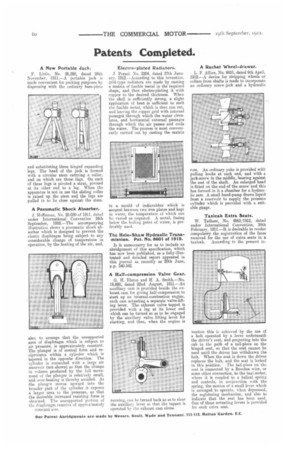Patents Completed.
Page 22

If you've noticed an error in this article please click here to report it so we can fix it.
A New Portable Jack.
F. Little, No. 26,280, dated 24th November, 1911.—A portable jack is made convenient for packing purposes by dispensing with the ordinary base-plate and substituting three hinged expanding legs. The head of the jack is formed with a circular stem carrying a collar, and on which are three lugs. On each of these lugs is pivoted a strut, pivoted at its other end to a leg. When the apparatus is not in use the sliding collar is raised up the stem and the legs are pulled in to lie close against the stem.
A Pneumatic Shock Absorber,
J. Hoffmann, No. 20.020 of 1911. dated under International Convention 16th September, 1910.—The accompanying illustration shows a pneumatic shock absorber which is designed to prevent the elastic diaphragm being subject to any considerable change of temperature in operation, by the heating of the air, and,
also, to arrange that the unsupported area of diaphragm which is subject to air pressure, is approximately constant. The plunger is of conical form and reciprocates within a cylinder which is tapered in the opposite direction. The cylinder is connected with a large air reservoir (not shown) so that the change -in volume produced by the full movement of the plunger is relatively small, and over-heating is thereby avoided. As the plunpr moves upward into the broader part of the cylinder it exposes a larger area to the pressure, so that the desirable increased resisting force is obtained. The unsupported portion of the diaphragm remains of approximately
constant size. Electro-plated Radiators.
.f. Porzel. No. 2204, dated 27th January, 1912.—According to this invention, grid-type radiators are made by casting a matrix of fusible metal in the required shape, and then electro-plating it with copper to the desired thickness. When the shell is sufficiently strong, a slight application of heat is sufficient to melt the fusible metal, which is then run out. and leaving the copper grid with internal passages through which the water circulates, and hortizontal external passages through which the air passes and cools the water. The process is most conveniently carried out by casting the matrix in a mould of indiarubber which is secured between two iron plates and kepi in water, the temperature of which can be varied as required. A metal, fusing below the boiling point of water, is preferably used.
The HeleShaw Hydraulic Transmission. Pat. No. 8601 of 1912.
It is unnecessary for us to include an abridgement of this specification, which has now been published, as a fully-illustrated and detailed report appeared in this journal as recently as 20th June, p.p. 340-342.
A Half-compression Valve Gear.
G. H. Illston and H. A. Smith.—No. 18,828, dated 22nd August, 1911.—An auxiliary cam is provided beside the exhaust cam for giving half-compression to start up an internal-combustion engine, each cam actuating a separate valve-lifting lever. The exhaust valve tappet is provided with a lug at its lower end -which can be turned so as to be engaged by the auxiliary valve lifting lever for starting, and then, when the engine is
running, can be turned back so as to clear the auxiliary lever so that the tappet is operated by the exhaust cam alone.
A Rachet Wheel-drawer.
L. F. Allien, No. 8451, dated 9th April, 1912.—A device for stripping wheels or collars from shafts is made to incorporate an ordinary screw-jack and a hydraulic
rim. An ordinary yoke is provided with pulling hooks at each end, and with a jack.screw in the middle, bearing against the end of the shaft. An enlarged head is fitted on the end of the screw and this has formed in it a chamber for a hydraulic ram. A small hand-pump draws liquid from a reservoir to supply the pressure cylinder which is provided with a suitable gime.
Taxicab Extra Seats.
W. Tatham, No. 4063/1912, dated under International Convention, 24th February, 1911.—It is desirable to render compulsory the registration of the fares received for the use of extra seats in a
taxicab. According to the present. in vention this is achieved by the use of a bolt operated by a lever underneath the driver's seat, and projecting into the cab in the path of a tail-piece on the hinged seat, so that the seat cannot be used until the driver has withdrawn the bolt. When the seat is down the driver replaces the bolt, and the seat is locked in this position, The tail-piece on the seat is connected by a Bowden wire, or some other connection, to the taxi meter, where it is coupled to a helical spring and controls, in conjunction with the spring, the motion of a small lever which is arranged to operate, when depressed, the registering mechanism, and also to indicate that the seat has been used. One of these actuating levers is provided for each extra seat.






















